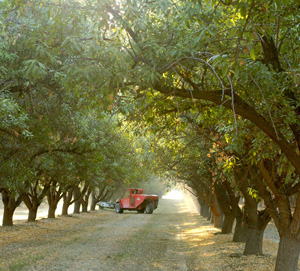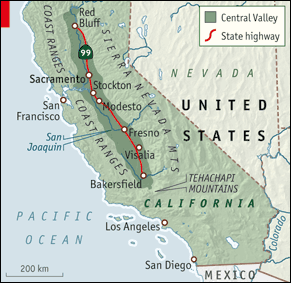http://www.economist.com/world/unitedstates/displaystory.cfm?story_id=15331478
California's Central Valley
The Appalachia of the West
Californias agricultural heartland threatens to become a wasteland
Jan 21st 2010 | FIELDS BETWEEN BAKERSFIELD AND VISALIA
From The Economist print edition
 Alamy
Alamy
MIKE CHRISMAN looks out from his SUV as he drives through seemingly endless rows of walnut trees on his property near Visalia, in central California. I have to be optimistic, Im so tied to this land, he says. His great-grandfather, after trying his luck in the Gold Rush, settled in Visalia in the 1850s, and the family has been there ever since. But as Californias secretary for natural resourcesa job at the intersection of the environmental and farming lobbies, perennially at loggerheads over the states scarcest resource, waterMr Chrisman also knows that optimism has become a minority view.
His land is in Californias Central Valley, a region that covers 19 counties and stretches for 450 miles (725km) from the Cascade mountains in the north to the Tehachapis in the south, and is bounded in the east by the Sierra Nevada and the west by Californias Coast Ranges. Much of it was an inland sea in its geological past, and its alluvial soils and Mediterranean climate make parts of it, particularly the San Joaquin valley in the south, about the most fertile agricultural region in the world.
But this status is at risk because water, the vital ingredient to make the soil productive, is increasingly scarce. Some of the reasons are natural; California has been in one of its periodic droughts since 2006, and climate change is a long-term threat to the states mountain snowpacks. Others are political; the pumps and aqueducts that carry water from the wetter north to the dry fields in the south are creaking with age, threatening ecosystems and endangering species.
Water is our biggest issue, says Bill Phillimore, the manager at Paramount Farms near Bakersfield, the largest grower of pistachios and almonds in the world, and of pomegranates and citrus fruits in America. Water used to be 20% of Paramounts costs, he says, but now accounts for 30%. As a result, many farmers are letting their fields lie fallow or switching from thirsty crops, such as cotton, to those that need less. Paramounts trees, lined up like soldiers on parade as far as the eye can see, are irrigated by tiny micro-sprinklers at their base so that water hits only the roots and no drop goes to waste.
Farming will not disappear, but whether it will be as big as it is now is a question, says Mr Phillimore, adding that If the agriculture goes away, there is nothing. In the San Joaquin valley agriculture provides almost 20% of the jobs. The alternatives are depressing and scant. For example, many of Californias prisons are sited in the Central Valleys wide expanses, in what is sometimes called an archipelago.

A big problem is that the workforce in the Central Valley is badly educated, says Carol Whiteside, the founder of the Great Valley Centre, a not-for-profit organisation whose aim is to improve the region. The largest farms are often still owned by the families that arrived a century or so agothe descendants of Portuguese and Dutch immigrants are big in dairy farms, for example. But most of the whites tend to be Okies who arrived from the dust bowl of the Great Plains during the depression, such as the fictional Joad family in John Steinbecks The Grapes of Wrath, who drove up and down in search of work on the stretch of Highway 99 where Paramount Farms now sits.
Economically, socially and educationally, their descendants have barely moved up. Nor have more recent immigrant groups such as the Hmong, Thai and Mien, who came to work in the fields during the 1970s and now live in Central Valley cities such as Stockton, Fresno and Modestoor, of course, the Mexicans, who have been coming since then and are now the majority of workers in the fields, where Spanish is the common language.
These demographic trends, combined with the water shortage, are causing worry. The Central Valley is already one of the poorest regions of the country. And its population, about 6.7m in 2008, is among the fastest-growing; it is expected to double in the next 40 years, as new immigrants continue to pour in looking for farm work.
This has led to comparisons with Appalachia, which has also relied on a declining extractive industry (coal mining) and has suffered from high unemployment, poverty and a relatively unskilled workforce. A report commissioned by Congress in 2005 argued that the San Joaquin valley is in some respects behind Appalachias coal country in diversifying its economy.
As the almond trees of the San Joaquin valley go into their February bloom, turning the plains white with their buds and abuzz with millions of bees who are temporarily imported to pollinate them, it may be hard to see devastation in the making. Nonetheless, the Central Valleys future looks increasingly barren.





